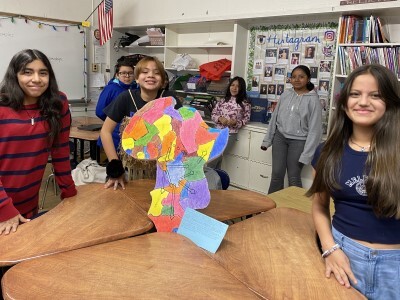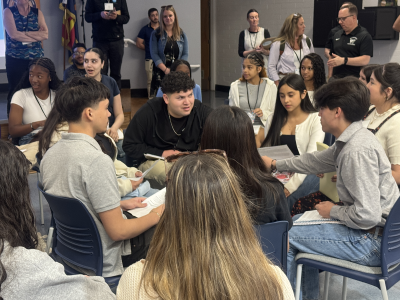Globalizing Dual-Credit Courses: The University of Pittsburgh Summer Institute for Pennsylvania Teachers
Topics
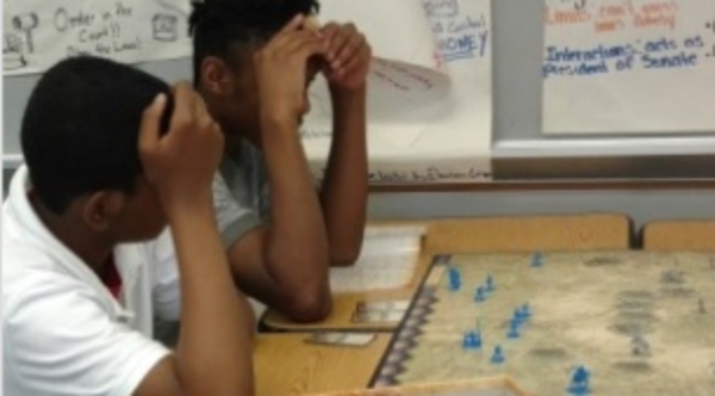
Educators are the lead learners in schools. If they are to enable powerful, authentic, deep learning among their students, they need to live that kind of learning and professional culture themselves. When everyone is part of that experiential through-line, that’s when next generation learning thrives.
Two high school teachers develop dual-credit courses in collaboration with the University of Pittsburgh. The courses emphasize global awareness and critical thinking, two critical competencies for postsecondary student success.
Zsuzsánna Magdó and Susan Dawkins, Center for Russian, East European, and Eurasian Studies at the University Center for International Studies, University of Pittsburgh
Global citizenship and educational equity—these two topics drive much of the current discourse on K-16 education.
More and more, school districts and higher education institutions foreground global awareness in their mission statements and programs, highlighting the need to prepare students to participate in a global economy and society. Educators, policy makers, and other stakeholders are also concerned about educational equity, including making postsecondary education more accessible to more students. Dual-credit programs, also known as college in high school, have the capacity to address both issues for a number of reasons. First, they offer high school students the capacity to earn college credits at a steeply reduced rate (in the University of Pittsburgh’s case, approximately 10 percent of tuition). They also have demonstrated higher success rates than credit-by-examination programs. In addition, dual-credit classes are based on year-long cumulative assessments of student learning outcomes rather than performance on one test, thus reflecting a fuller extent of knowledge and skills students acquire in class. For these reasons, dual-credit courses provide an excellent venue for helping both teachers and students engage with infusing global content into college and high school courses.
For the past two years, two offices at the University of Pittsburgh—the University Center for International Studies (UCIS) and the College in High School (CHS) program—have presented a week-long institute to enhance global content in dual-credit social studies and world language courses. At the Summer Institute for Pennsylvania Teachers, we provide orientation and training to give high school teachers the tools to offer their courses for dual credit, enabling diverse students, including economically disadvantaged students, to earn college credit. Equally important, university faculty and staff help new CHS teachers develop more intentionally global curricula for dual-credit courses. The expertise of UCIS staff and faculty affiliates and generous financial support from the Longview Foundation for Education in World Affairs and International Understanding enable us to provide support for teachers to create engaging and globally focused curricula and to access university resources.
Two teachers from the inaugural Summer Institute share their experiences here. Victoria Abbondanza, who has taught in an urban parochial school and a suburban school district, addresses the opportunities availed by teaching dual-credit Latin, a “dead” language that lives on in diverse languages and cultures. Wendy Moore, a history teacher in a school district with many economically disadvantaged students, discusses the benefits of teaching a Western civilization course for college credit and emphasizing a more intentionally global perspective. Both speak to the benefits for diverse student populations, including economically disadvantaged students, of dual credit that the CHS program at Pitt offers. They also address the possibilities of fostering global connections and critical thinking in these classes in order to help students better prepare for postsecondary education and become active participants in a global society.
Teaching Classical Latin as a Springboard for Critical Global Awareness
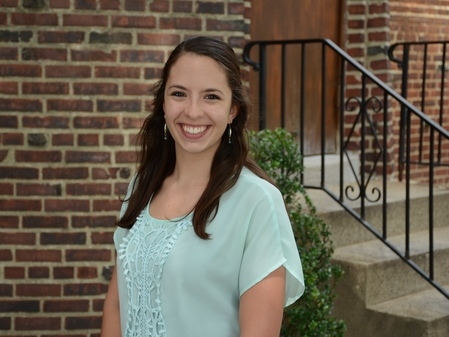
Victoria Abbondanza, Beaver Area High School
As an early career teacher, I seek as much professional development as I can. I consult colleagues, reach out to former teachers, take courses and workshops, and research on my own. I look for ways to better relate material to my students, which can be challenging, as I have taught in very different environments, first in an urban parochial school, and currently in a more suburban district. Specifically, I have sought to incorporate more global perspectives into my curricula. I knew that the College in High School program would provide a strong opportunity for my students to experience the rigor of a college class and to (potentially) earn college credit before graduating from high school. What I did not know was how much I would learn as I took in this amazing experience, beginning with the Summer Institute for Pennsylvania Teachers, which helped me to foreground global awareness in my teaching of dual-credit "Latin Prose and Verse."
Preconceived Ideas Challenged
After going through the application and acceptance process for the CHS program, then walking into the first day of “school” with other teachers, my preconceived ideas were quickly blown out of the water. I had approached the Summer Institute thinking that I would learn the ins and outs of the CHS program so that I could offer college credit to my few students who were continuing with their Latin coursework. In teaching a classical language, I work with material in which there are no new developments in the language or culture. I learned, however, that teaching Latin has great potential for enhancing global awareness, appreciation, and competency. At the Summer Institute, I spent a week with educators who were beginning their journeys as CHS teachers. Participating with teachers in different disciplines, including history, world politics, and world languages, provided an opportunity to think more deeply about incorporating global approaches in addition to completing training to teach a high school class for college credit.
The week consisted of presentations on CHS-specific topics, such as aligning our curriculum with university requirements, along with broader concepts, such as academic standards. Regardless of the presentation topic, each speaker incorporated a theme of global awareness and application. I had the chance to see this perspective from educators in other subject areas, as I was the only Latin teacher at the Summer Institute. I more than welcomed the exposure to the other subjects as I took away ideas that I use in my classroom today. It was helpful to see various methods and how I could apply them to my own curricula. The workshop facilitators and other participants highlighted global competency and applications outside of the individual courses. The Summer Institute opened my eyes to the possibilities that we as teachers could utilize to make our students global citizens.
Approaching the Classics with an Interdisciplinary Lens and Global Appreciation
I learned a great deal from the sessions on teaching modern languages approaches. I particularly welcomed the presentations about ACTFL (The American Council on the Teaching of Foreign Languages) standards. ACTFL provides teaching standards for world language teachers, and these standards foreground global competence. I have found that teaching a “dead” language, in fact, gives me an advantage, as it is the source from which many languages and cultures have come. I teach a Latin prose course, which covers Vergil’s Aeneid, one of the best pieces of Latin literature. This epic poem is rich with the hero’s journey, symbolism, and poetic themes. Because the text has a wealth of content, I have utilized multiple interdisciplinary methods to engage students. Aside from translating the text, students examine artwork from different cultures and time periods, compare archaeological evidence to the fictional story, and evaluate the English text by rewriting their own version of the epic. Most of my approaches include critical analysis, an important skill in a global community. As students enter the world outside of school, they will be tasked with giving opinions, making decisions, and collaborating with others. An ability to evaluate situations is essential in interaction and communication, and the CHS curriculum has given me a platform to demonstrate those skills. Meeting the fundamental course requirements of translating Latin text to English provides a small but deep root from which I can help branches to grow.
I was saddened to learn that I could only attend the Summer Institute once, but I am elated to have been a part of it. I never thought that a non-spoken language could lend itself to a modern global community. The program helped me to blend worlds that are millennia apart and show my high school students what it means to be a global citizen in this day and age.
Incorporating Global Perspectives in a Western Civilization Course
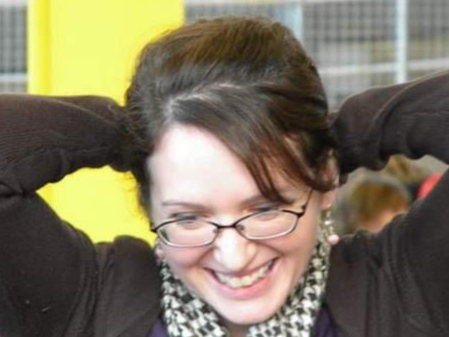
Wendy Moore, Pittsburgh Science and Technology Academy
I saw the email about applying to teach a dual-credit College in High School course through the University of Pittsburgh. I hesitated because I wasn’t sure if it was the right choice for my students. My "Western Civilization" class focuses mainly on European history. The students in my large urban district come from all backgrounds. I questioned whether my class would replicate a biased representation of history, focusing exclusively on Europe. My fears were for naught due to the Summer Institute for Pennsylvania Teachers. The Summer Institute prepared me to teach dual-credit courses to high school students and showed me new ways to foreground global citizenship and awareness in my teaching of Western civilization.
Learning from Experts and from Peers
During the Summer Institute, we, fellow social studies and world language teachers, met with experts in the fields of global studies and education to learn how to incorporate international content into our courses. The professional development was unique in the sense that we met with experts and shared ideas with other teachers, and then had the opportunity to work these concepts into our syllabus. The time given to do the work with time and space to collaborate not only with other new CHS teachers but also with experienced CHS teachers and university staff and faculty enabled me to fine-tune my teaching style. My most important take-away on global education was to incorporate a variety of perspectives and points of view in teaching historic time periods through the use of primary sources as well as the wonderful sources of information available through the extensive University of Pittsburgh library.
Using Primary Sources to Foster Global Awareness and Critical Thinking
The Summer Institute gave me space to consider ways to connect events in Western history to contemporary global issues. For example, I created a lesson plan on Enlightenment philosophies, beginning with a translation of Immanuel Kant’s What is Enlightenment? From there, students researched various Enlightenment philosophies. Their research culminated in our class staging a Salon in which students acted as the individual philosophers and discussed current events. We switched topics every 10 minutes or so to provide a breadth of topics. By applying Western philosophy to current events, students could make critical global connections.
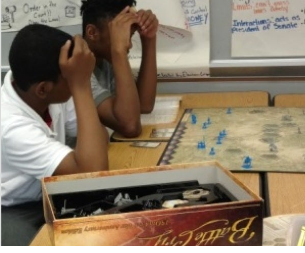
Students engaging in a historical game.
(Courtesy of Wendy Moore)
By incorporating varied perspectives and points of view, students could access elements of history that are not as apparent in traditional textbooks. The focus on globalization encouraged the creation of simulations, debate, and argument. Students questioned the actions of past and current governments, and then analyzed the cause and effects of various events. The training I received at the Summer Institute helped me to help students find connections between past and present as well as among different parts of the world.
Global Awareness and Educational Equity
As I mentioned before, my school is in an urban district that serves under-represented groups. Many of my students are first-generation Americans or have parents who did not attend college. The opportunity to earn college credit in high school at a drastically reduced fee enabled many to view themselves as college students. After the course in high school, their perspectives changed. They went from doubting their abilities and a very local view of the world to believing they could succeed through hard work and taking on a global perspective of events. If I had listened to my initial doubts and not attended the Summer Institute for Pennsylvania Teachers, this change would not have occurred in my students.
Learn More about Globalizing Dual-Credit Courses
To see some of the recorded sessions from the 2018 and 2019 Institutes, please visit the University Center for International Studies Outreach website.


